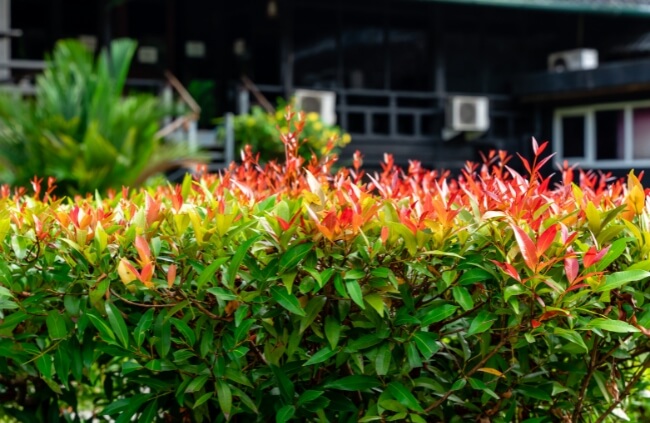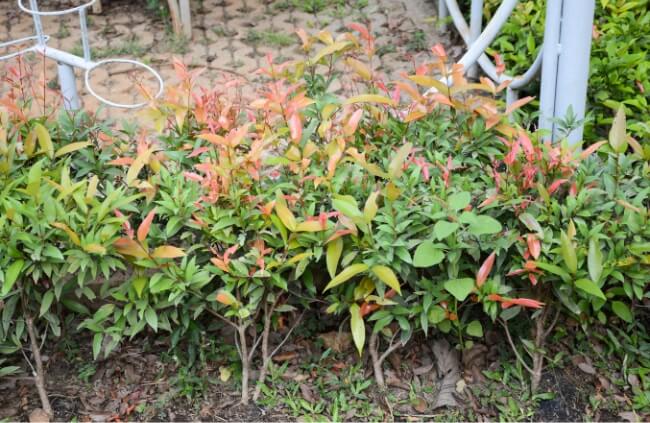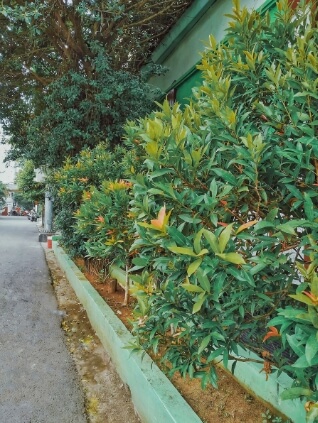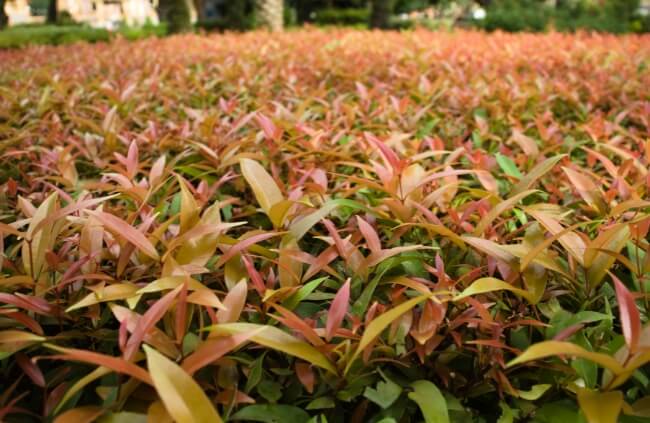Are you looking into planting lilly pilly hedge? With dense evergreen foliage and beautifully fragrant spring flowers, lilly pillies make stunning native hedges for any Australian garden. Like most native shrubs, lilly pillies are actually small trees, but respond well to pruning, making them an ideal hedge choice.
Despite a few mineral sensitivities, lilly pillies are easy to grow, and quick to establish, and once they’re in place, suffer from relatively few diseases, making them a great long lasting choice for a hedge.
More...
Genus: | Syzygium |
|---|---|
Species: | various |
Origin: | Australian native |
Common Names: | Chinese Apple, Coast Satinah, Eungella Gum, Lilly Pilly |
Location: | Outdoor |
Type: | Small tree, commonly used for hedging |
Growth: | up to 5 m tall |
Sun requirements: | Full sun or light shade |
Foliage Colour: | Green (new growth has red tips) |
Flower Colour: | Pink or white |
Flowering: | Spring |
Edible Parts: | Edible berries |
Maintenance level: | Low |
Poisonous for pets: | Non-toxic to cats and dogs |
What Makes Lilly Pilly a Good Hedge Plant?

Lilly pilly is undeniably popular as a hedging plant, but it’s not just popular for the sake of tradition, it’s popular because it’s easy to grow, and gives brilliant results.
I’m a big advocate of deciduous hedges, because they offer seasonal change, and generally more food for wildlife, but when it comes down to the simple bones of garden design, evergreen hedging looks better for longer.
And lilly pilly breaks the mould slightly, with evergreen foliage, but plenty of seasonal change too. In late winter and spring, its new foliage emerges as bright red, fading through the year. In spring the flowers accompany stunning foliage in beautiful pompom structures.
Because it has a very short dormant period, and holds its leaves a few inches back on its stem, it’s easy to prune and retain a solid structure. It usually continues to flower well in spring after an autumn pruning too, meaning there’s no compromise between shape and blooms.
Lilly Pilly Varieties for Hedging
There are over sixty native species of lilly pilly in Australia, and a few that grow well here but are actually native to South Asia. Acmena, Syzygium and Waterhousea are all referred to as lilly pillies, but Acmena was reclassified into Syzygium recently.
Don’t worry though, if you see any in garden centres labelled as either genus, they will grow in the same conditions and with the same methods as this article describes.
They are nearly all small trees, and some can reach 5 m tall with time, so we’ve chosen some of the more controllable varieties below to give you guaranteed success and neat hedges for years to come.
Key factors in choosing the best lilly pilly for your hedge should include size, pest resistance and form.
Some dwarf lilly pillies like Syzygium smithii ‘Minor’ (formerly Acmena smithii ‘Minor’) are incredibly popular and easy to care for, but Syzygium australe ‘Resilience’ is the one that seems to stand the test of time when it comes to pest resistance.

Source: Jim's Mowing Australia
1. Syzygium australe ‘Resilience’
The most famous psyllid-resistant lilly pilly cultivar is Syzygium ‘Resilience’, a cultivar of S. australe. Its foliage is wider than most, offering a bushier look, with a more fluffy finish when pruned, but also incredibly dense at the same time.
Reaching up to 5 m tall, it’s a great way to add privacy to your garden, but looks at its best when pruned to about 3 m tall as a reasonably narrow hedge. Each plant can cover 3 m across, but can be planted closer together if establishing younger plants.


Get Your Free Guide:
Master Growing Australian Natives eBook
A Must Have Complete Guide for Every Australian Garden
Get Your Free Guide:
Master Growing Australian Natives eBook
A Must Have Complete Guide for Every Australian Garden
2. Syzygium paniculata
Also known as Backyard bliss of Neighbours-be-Gone, S. paniculata grows to an impressive 6 m, even with regular clipping, generally putting on about 30 cm of growth per year until it’s fully grown, when it will slow down.
Like all hedges, it’s important to prune during the growing stage so you don’t end up with a bare base.
3. Syzygium smithii ‘Minor’
Syzygium smithii is a tall lilly pilly, with not many specific benefits, but the dwarf cultivar, S. smithii ‘Minor’ grows to a maximum height of 3 m if left to grow unclipped, but with slow growth making it ideal from area divisions.
S. smithii ‘Minor’ definitely performs at its best when clipped into a 1-1.5 m tall hedge, with some teases at views beyond.
4. Syzygium ‘Cascade’
One of the best pink-flowered lilly pillies is Syzygium ‘Cascade’, a hybrid between S. luehmannii and S. wilsonii. Its gorgeous cotton candy pom poms tend to bloom in clusters, covering bushes right through spring, with fragrant and beautiful flowers.
Growing to around 2 m tall, and easy to prune with some good psyllid resistance, Cascade Lilly Pilly is one of the most reliable cultivars there is.
5. Syzygium australe 'Bush Christmas'
One of the most resilient lilly pillies, and the one that has always performed best for us as a compact hedge is Syzygium ‘Bush Christmas’. It's later flowering than many too so generally blooms around Christmas time, often for the full course of summer.
Fine foliage means denser displays of the fresh red growth too, making topiary a thing of true beauty.
How to Grow a Lilly Pilly Hedge
Lilly pilly plants tend to come with quite established root balls, but they do like a good root run if you can give it to them, so before you plant them, regardless of soil or position, you should dig down to about twice the depth of the pot, and twice the width.
If planting a hedge, the easiest way to do this is to dig out a deep trench, and backfill half before planting.

Where to Plant Your Lilly Pilly Hedge
Full sun or partial shade will both work for your lilly pilly hedge. In summer, their leaves can crisp if they really are baking, but with reasonable watering during hot weeks, it’s not usually a problem.
Taller varieties tend to cope better with full sun (they have to!), but shorter varieties or tall types that are pruned shorter are generally under a touch more stress, so some shade can be useful to get them through severe droughts.
Lilly Pilly Hedge Spacing
Most cultivars and species types of lilly pilly grow to an ultimate width of 3 m, but it takes time and a lot of patience, particularly if you’re planting young plants, to begin with.
Generally speaking, lilly pillies can cope with being planted about 70-80 cm apart. Any closer and they will compete for nutrients while they establish, any further and it will take quite a few years for them to link up and form a dense hedge.
Preparing the Soil for a Lilly Pilly Hedge
Lilly pillies like rich but well-drained soil. If you’re gardening on clay, the soil will need some improvement, and on sandy, it will likely need nutrients added. The ideal conditions are deep, loamy soil, so it’s worth digging through plenty of rotted organic materials like compost or soil improver before planting.
As flowering shrubs, they perform best with ongoing care, and that means either mulching or feeding your soil on an ongoing basis after planting.
How to Propagate Lilly Pillies
Lilly pilly can be propagated from ripe seed, but it takes time. For faster results, you can take cuttings at different times of the year to grow your own lilly pilly hedge from scratch.
Check out our main guide to growing lilly pillies in all their forms for more information on how to propagate these beautiful bushes.
How to Care for Your Lilly Pilly Hedge
Lilly pillies take one full growing season to really establish their roots, so will need regular watering for their first year. In their second year, regular feeding can boost both flower and foliage growth, meaning you can start pruning into your desired shape.
Once they’ve established and are growing steadily, they require little ongoing care, but there are still a few things you can do to keep them looking their best.

Feeding and Mulching a Lilly Pilly Hedge
Any balanced fertiliser will support the development of lilly pilly hedges, even those with phosphorus. Unlike many Australian natives, lilly pilly actually quite likes phosphorus, in limitation.
Primarily though, you want to focus on nitrogen, potassium and calcium, which support foliage growth and flower strength. Adding organic matter to the soil (manure in particular) will do this with a single annual application, but monthly feeds or liquid seaweed are a good way to boost nutrients when needed.
Watering Your Lilly Pilly Hedge
Even once established, lilly pilly is a plant that likes moisture. Damp conditions are not desirable, but well drained soil with reasonable rainfall, and some additional irrigation during summer will suffice even in the hottest climates.
Pay attention to the soil during spring, summer and autumn in the first few years, watering if it starts to dry out. If the soil is moist at the surface, avoid watering altogether.
Pruning a Lilly Pilly Hedge
Any hedge needs regular pruning when it’s young, and less as it gets older. Once it’s established, and has a truly dense outer edge, your lilly pilly will do well on just two prunes per year, but for the first couple of years it will focus on new shoots, stems and foliage, sometimes sending tall shoots out that ruin the look of your hedging.
Prune regularly for the first two or three years, maybe once a month, depending on growth rate. Not only does this control growth, but it will encourage side shoots, new lateral growth, and mean that it has a good solid structure by the time it establishes.
Check out our reviews of the best tools to help you in your pruning tasks:
Problems and Pests with Lilly Pilly Hedges
Lilly pillies are fairly low-maintenance hedges, but they are also a member of the Myrtle family, which does make them somewhat susceptible to common myrtle diseases like rusts and funguses.
There are some endemic pests too, which are worth getting to know so you can spot the signs and act fast, particularly lilly pilly beetles and psyllids.
Aphids, leaf borers, and scale are commonly found on mature lilly pilly plants, but don’t cause much damage. They can be treated by direct application of rubbing alcohol or neem, or wiped or sprayed off the leaves regularly.
More specific pests are psyllids and the lilly pilly beetle:
Psyllids
Lilly pilly psyllids (Trioza eugeniae) are most visible on new growth, but have a much longer lifecycle. Their nymphs take shelter in galls on the underside of leaves, which the plant forms as a reaction to bites and wounds.
The only real treatment once they take hold of a plant is to cut back the affected growth and burn it. Feeding the plant, and keeping it well watered will usually deter these pests, but some systemic insecticides are effective if applied with care.
Lilly Pilly Beetles
Paropsides calypso, the Lilly pilly beetle, are voracious feeders, and can completely strip the new foliage of lilly pillies. They look like ladybirds, but with completely green bodies and no spots.
They are native to NSW but are now found across most of Australia. The only way to get rid of them is to kill the adults and make the plants less attractive to them. Attracting predators like wasps can help control young bugs, but disposing of the bugs when you see them is the only guaranteed control measure.
Like most native shrubs, the most common cause of any disease is overwatering, leading to problems like Phytophthora root rot and powdery mildew on leaves. Each is a simple fungal infection, but both can be problematic in the longer term and will require treatment through reducing watering and cutting out affected sections of the plant.
Myrtle rust is another fungal problem passed between plants by insects, particularly in wet weather or humid summers.
Frequently Asked Questions About Lilly Pilly Hedges

How long does it take to grow a lilly pilly hedge?
Lilly pilly hedges take about five years to really establish, but won’t reach their full height for around ten years (if you’re aiming for a 2-3 m tall hedge). They grow about 30 cm per year, but that should be regularly pruned to create a dense structure as it develops.
What are the disadvantages of lilly pilly hedges?
Lilly pilly hedges are susceptible to several common native pests, which is one of their main disadvantages, but with proper care, and clever plant selection, these problems can be overcome, or avoided altogether.
What is the fastest-growing lilly pilly hedge?
Syzygium paniculata, also known as Backyard bliss or Neighbours-be-Gone is one of the fastest-growing lilly pilly varieties and can reach heights of up to 6 m in time.
What is the lifespan of a lilly pilly hedge?
Lilly pillies live for well over twenty years, and with proper care will last forever in a garden.
Are lilly pilly berries edible?
Lilly pilly berries are not just edible, they’re delicious. The edible fruits follow flowers in spring or summer and can be used to make jams, infusions, and all sorts of other culinary wonders.
Wrapping Up Our Guide to Lilly Pilly Hedges
If you’re looking for a new native hedge for your garden, lilly pilly really is one of the best choices. They are reasonably fast-growing, but not so fast that they’re hard to control. Once established they hold their form with limited pruning and require just one application of slow-release feed or compost each year to thrive.
The only caution I will remind you of before rounding off is to try and choose a cultivar of lilly pilly that has true resistance to psyllids. Lilly pilly beetles will come and go, but psyllids should be avoided at all costs, and growing lilly pillies is a long-term project, not a quick fix.
Published on August 27, 2023 by Nathan Schwartz
Last Updated on September 20, 2024




